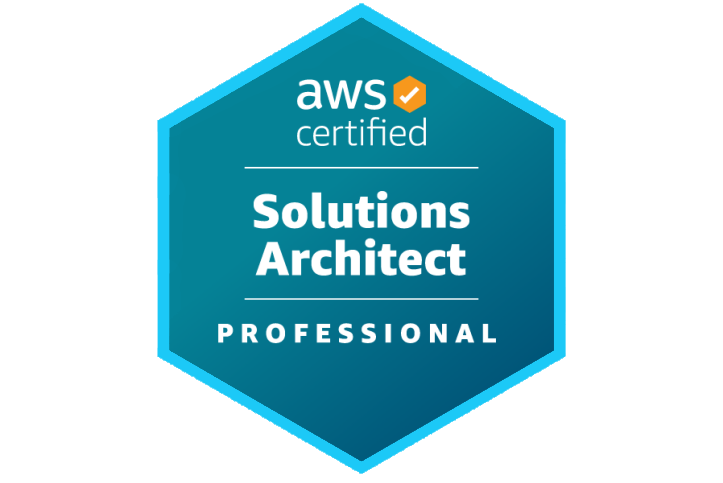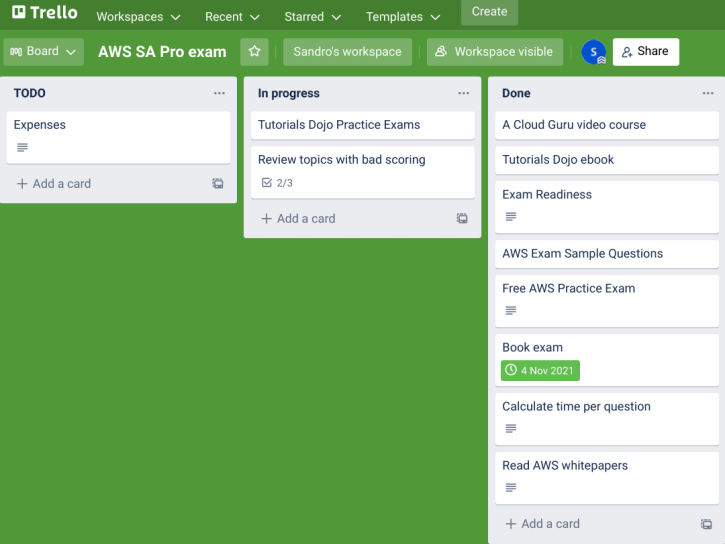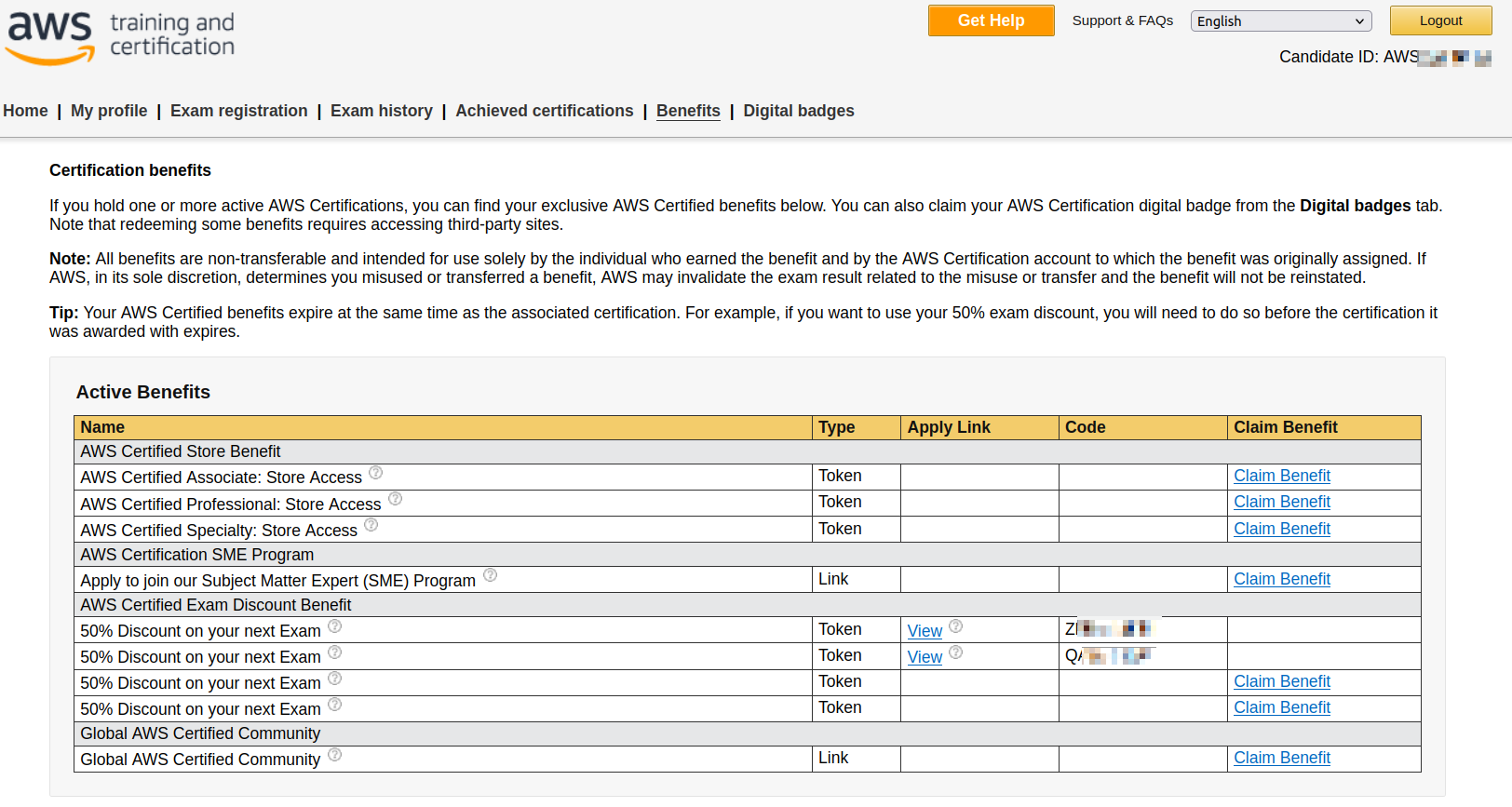Please note that this post, first published over a year ago, may now be out of date.
A few months ago, I passed the exam for the AWS Solutions Architect Professional Certification (or SA Pro for short) and I’d like to share some tips and resources I used. I hope this can help you preparing the exam and getting the SA Pro certification.
But before embarking on the journey to obtain an AWS certification, it’s worth while asking why bothering getting AWS certified. Here are some good reasons:
- Better job opportunities and salary: AWS certified engineers are in high demand and can earn top-paying salaries. AWS consultancy partners (like The Scale Factory) need to have a certain amount of AWS certifications in order to retain their AWS consultancy status and move to the next consulting tier so they are big recruiters of AWS certified engineers.
- Professional growth: you want to deepen your AWS knowledge, enhance your skills, and progress your career.
- Professionalise your team: become the AWS go-to expert in your organisation, upskill your team, and motivate other colleagues to get certified.
In my case, professional growth was the main driver as I wanted to deepen my AWS knowledge at a professional level. In addition, we are strongly encouraged at The Scale Factory to get the SA Pro certification as it is extremely useful for AWS architectural design and workshops we regularly do for our clients.

Getting started and organized
The best place to start is to read the AWS Certified Solutions Architect Professional page and the SAP-C02 official exam guide. You may also test your current AWS security knowledge by trying to answer the SAP-C02 sample exam questions. Sample questions give you a flavour of what to expect during the exam (in case this is your first AWS exam) and highlight areas where you may have knowledge gaps. Don’t worry if you don’t score particularly well on your first attempt, keep track of how many answers you got right, and try the test again before your exam date, you will certainly score better and realize how much you’ve learnt.
“A goal without a plan is just a wish” says an old saying (some attribute it to the French writer Antoine de Saint-Exupéry) so getting organized on what to study and when to take the exam is an important initial step. When embarking in a new project, my project management technique is to create a Trello board and start recording all the things I need to do to reach my project goals. For the AWS exam I created Trello cards for the resources I wanted to study (i.e. videos, books, white papers, practice exams, etc.) as well as for the practicalities (e.g. booking the exam). A Trello board (or indeed any project management tool) can help you navigate the study material, visualise your progress, and make sure you don’t forget important bits when the exam date is approaching.
This is how my Trello board looked like few days before taking the exam:

Treat the board as a compass and as a tool to track your progress. Don’t get bogged down to record every single white paper, video course or book you may want to check out. The important thing is to get organized and start studying - you will create new cards and move old ones as you study along.
Study Resources
I prepared for the exam using a mix of study materials which included videos, eBooks, AWS documentation and white papers, hands-on labs, and practice exams. I personally find useful to mix the course material as it reinforces my learning. Furthermore, a single resource may cover a topic insufficiently or present it on a limited angle so it’s always good to mix and match.
Videos
I initially took the video course on the AWS Certified Solutions Architect Professional by A Cloud Guru. I usually recommend A Cloud Guru’s video courses to prepare for AWS exams - in fact, I successfully prepared and passed the AWS SysOps Associate exam and the AWS Security Specialty exam with A Cloud Guru’s video courses. However, this time I found the video course less useful and not necessarily the most time effective resource to prepare for the SA Pro exam. I already had a fair amount of AWS knowledge thanks to previous practical experience and AWS certifications so I was already familiar with some of the topics covered by the video course. On the other hand, I was unfamiliar with some of the AWS services that are part of the exam but I hadn’t used (in my case, it was services and concepts like AWS Directory Service, identity providers and federation, Cognito, Machine Learning services, etc. ). I felt I wasn’t enough prepared after the video course and found it a bit generic and lacking any deep dive into the topics I was struggling with. Furthermore, the quizzes and exam simulation in the video course are not very similar to the questions you get in the real SA Pro exam: unlike other AWS exams, the SA Pro exam contains many long and convoluted questions which were not often present in the quizzes and simulation I did on the video course. So once I completed the video course I practised the exam via the exam sample questions and the free AWS practice exam. This is when I started panicking because I was taking too long to answer the questions and scored below the minimum passing threshold of 75%. I wasn’t used to those long questions and I didn’t spend enough time on some of the topics I was new to.
Please don’t get me wrong: there is value in taking the SA Pro video course by A Cloud Guru and you will definitely learn a lot. But for preparing the exam at the level I was at I found other resources more useful and more time effective (more on this in the next section). I know A Cloud Guru regularly reviews their content so I’m confident they will improve their video course. If you take their video course bear in mind that A Cloud Guru courses are not cheap and require a monthly subscription (you can’t just buy a single video course but you can stop the subscription when you pass your exam).
Books
I personally love studying on physical books as they keep me away from screens and internet distractions. Unfortunately, unlike other AWS certifications at the associate level, there aren’t many books specifically dedicated to the AWS Solutions Architect Professional Certification. At the time I was studying for the exam I could not find any book published by major publishers. A promising book which is scheduled to be released in 2023 is the AWS Certified Solutions Architect Professional All-in-One Exam Guide to be published by McGraw-Hill. I read exam preparation books by this publisher in the past and they are usually very good and rigorous.
One eBook I consulted (but didn’t fully read because of I was running out of time) is the Tutorials Dojo Study Guide eBook for the AWS Certified Solutions Architect Professional. This is an eBook covering the exam curriculum in a very detailed and practical way. It has more the format of a cheat sheet than a fully fledged study guide but it goes straight to the point and contains many screenshots of the AWS console that guide you through the most complex configurations you need to understand for the exam. Material from the eBook is also used as a reference for explaining the answers of the Tutorials Dojo Practice Exams (more on this later). In fact, if I had to resit the exam, the two main resources I would focus on would be this eBook and the Tutorials Dojo Practice Exams. They are also much cheaper than some video courses as the bundle eBook + practice exam usually costs around 20 US dollars. If you have previous experience with AWS and AWS certification exams, these are the most time effective resources and are extremely good value for money.
AWS documentation
While studying on a video course or a book, you’ll get plenty of references to the official AWS documentation, white papers, and FAQs. In fact, the AWS exam preparation page lists all the white papers and FAQs you should read for the exam. To be honest, I didn’t read every single link to the AWS documentation which was thrown at me but I skim read lots of these web pages and white papers, in particular for the AWS services I was less familiar with. I personally found very useful the white paper on Backup and recovery approaches on AWS as we help several customers implementing backup services and disaster recovery strategies.
Hands-on Labs
Some video courses offer hands-on labs to practise what you learn during the course. For example, A Cloud Guru offers hands-on labs as part of their subscription offering and the SA Pro course has several labs as video content that you can practise on your own AWS account.
AWS Well-Architected Labs are hands-on labs content developed by AWS to build AWS infrastructure using architectural best practices. They cover the six pillars of the Well-Architected Framework which is a core topic for the exam. I did some of the intermediate and advanced labs using my AWS account and they were very easy to follow through. These labs complement well the theory that you learn elsewhere and give you that practical knowledge that is invaluable when working as an AWS engineer - and useful to pass the exam too!
Exam rehearsal
Rehearsing the SA Pro exam is one of the key skill you should practise during your exam preparation. Passing an AWS certification exam is not only a technical challenge but also an exercise in time management and interpreting what the exam question is asking you. Some questions in the exam are long-winded and can take up to a minute to be fully read. They are also written in a way to trick you and can be all technically correct so you have to find the answer that best matches the question. So get familiar with the exam mechanics - especially if this is your first AWS exam - and don’t leave the exam practice to the day before the exam.
These are the resources I used to rehearse the exam:
- Exam readiness: AWS provides a free 4 hour exam readiness course which covers the mechanics of an AWS certification exam and sample questions. I recommend you watch it, especially if it’s the first time you sit an AWS exam. The course shows the structure of the exam questions and techniques for selecting the correct answers. Even if you’ve done an AWS exam in the past, the course is useful because it contains several sample questions on each section of the exam. You can pause the video to attempt the question and then resume it to reveal the answer with an explanation of why the other answers are wrong.
- Sample exam questions: reattempt the sample exam questions I mentioned earlier and see how many correct answers you get now.
- Official practice questions: AWS provides an official practice question sets featuring 20 questions and simulating the exam environment. These practice exam used to be charged but are now free via AWS Skill Builder.
- Mock exams: The best mock exams I used are those by Tutorials Dojo. In fact, during the real exam I got a couple of questions which were exactly framed like the ones I practised on Tutorials Dojo. The killer feature of these mock exam is the review mode: you can practise exam questions and immediately reveal the answer with a clear explanation and AWS references on why an option is right or wrong. There is no time limit in the review mode so you can regularly practise and review topics even if you just have an hour available to study. Tutorials Dojo also provides a section based mode where you can focus on a specific domain and a timed mode which simulates the exam environment. If you have a little time to prepare I strongly recommend to focus on these mock exams.
- System test: if you’re going to sit the exam at home, make time to run a system test and check the requirements for remote invigilation (I talk about that in more detail later in the article).
The SA Pro exam has a passing score of 750 so each time I practised a mock exam or a set of sample questions I checked if I got at least 75% of the answers right. This confirmed I was ready for the exam and highlighted some of the areas which I needed to review.
Practicalities
You may want to book the exam in advance to set a strict deadline for finishing your study (there is nothing more motivating than a deadline!) or cover the study material, do some practice tests, and make sure you score above the pass threshold before booking the exam. I personally prefer to cover most of the study material first and then book the exam few weeks in advance.
To book an exam go to the AWS training and certification page and sign in with your Amazon (not AWS) account. You should sign in using your APN account if, like me, you work for a firm that is part of the AWS partner network. You are then either prompted to create an AWS certification account (if you don’t have one already), or redirected to your AWS certification account.
If you take the exam in English and English is not your first language, you can request non-native speaker addition time: this adds 30 extra minutes to your exam so that you’ll have 210 minutes instead of 180 to complete it. To benefit from extra time you must request it via the Request Exam Accommodations button in your AWS certification account. Make sure to request it before you book the exam as it is not possible to add it afterwards. The approval of the exam accommodation is usually immediate. Note that the SA Pro exam can also be taken in French, German, Italian, Japanese, Korean, Portuguese, Chinese, and Spanish.
Before booking you can also check if you are entitled to a discount for the exam (which at the time of writing costs 300 US dollars). For example, if you passed an AWS certification within the last 12 months, you are entitled to a 50% discount on the exam price and you can claim this benefit via the Benefits tab:

You can schedule your exam with Pearson VUE and choose to sit the exam:
- At a testing centre: you can find your nearest Pearson VUE test centre here. Make sure you check the current regulations as they can change quickly. I personally prefer to sit the exam at a test centre because I don’t have to worry about my internet connection going down or installing software that takes control of my computer. In addition, going to a test centre puts me in ’exam mode’ and focuses my attention on the exam without having external distractions.
- At home: since March 2020, AWS allows you to take all certification exams at home, with online proctoring. If you are interested in this option, read AWS’s own blog post 5 tips for a successful online-proctored AWS Certification exam which covers what you need in order to take the exam from the comfort of your home. In particular, pay attention to the system requirements and perform a system test. Note that you cannot take the exam on Linux, and cannot use a secondary monitor. Before the exam you need to install some software on your computer (using administrator privileges), which asks you to quit all your other programs and grant access to your webcam, microphone, and screen.
Before starting the exam at home you are asked to photograph your identity document, your face, and your workspace from a few different angles, and the online proctor may ask you questions about your workspace. During the exam, your webcam and microphone must remain on all the time and you cannot leave the room nor let anyone in.
On the day of your exam make sure you had a good night sleep, a good breakfast, and you are ready to keep your attention focused for 3 hours. Some exam questions could be quite long to read but make sure you read the question and all the answers carefully. You can also mark questions for review and revisit them later. But if you use this option, I’d recommend to choose a temporary answer as you may not have enough time (or brain) to revisit it later.
Wrap-up
I hope these tips and study materials will help you achieving the AWS Solutions Architect Professional Certification. Passing the exam is important but I strongly believe that learning is the most important thing: you will use what you’ve learnt, I can guarantee that. Happy learning and good luck with the exam! 🤞
I’ve updated this article on 24th February 2023 to cover changes since then.
Interested in joining our team? We’re friendly and inclusive, so if you have the skills and experience, I hope you would consider applying regardless of your age, gender, sexuality, race or physical ability. The Scale Factory is hiring.
This blog is written exclusively by The Scale Factory team. We do not accept external contributions.

